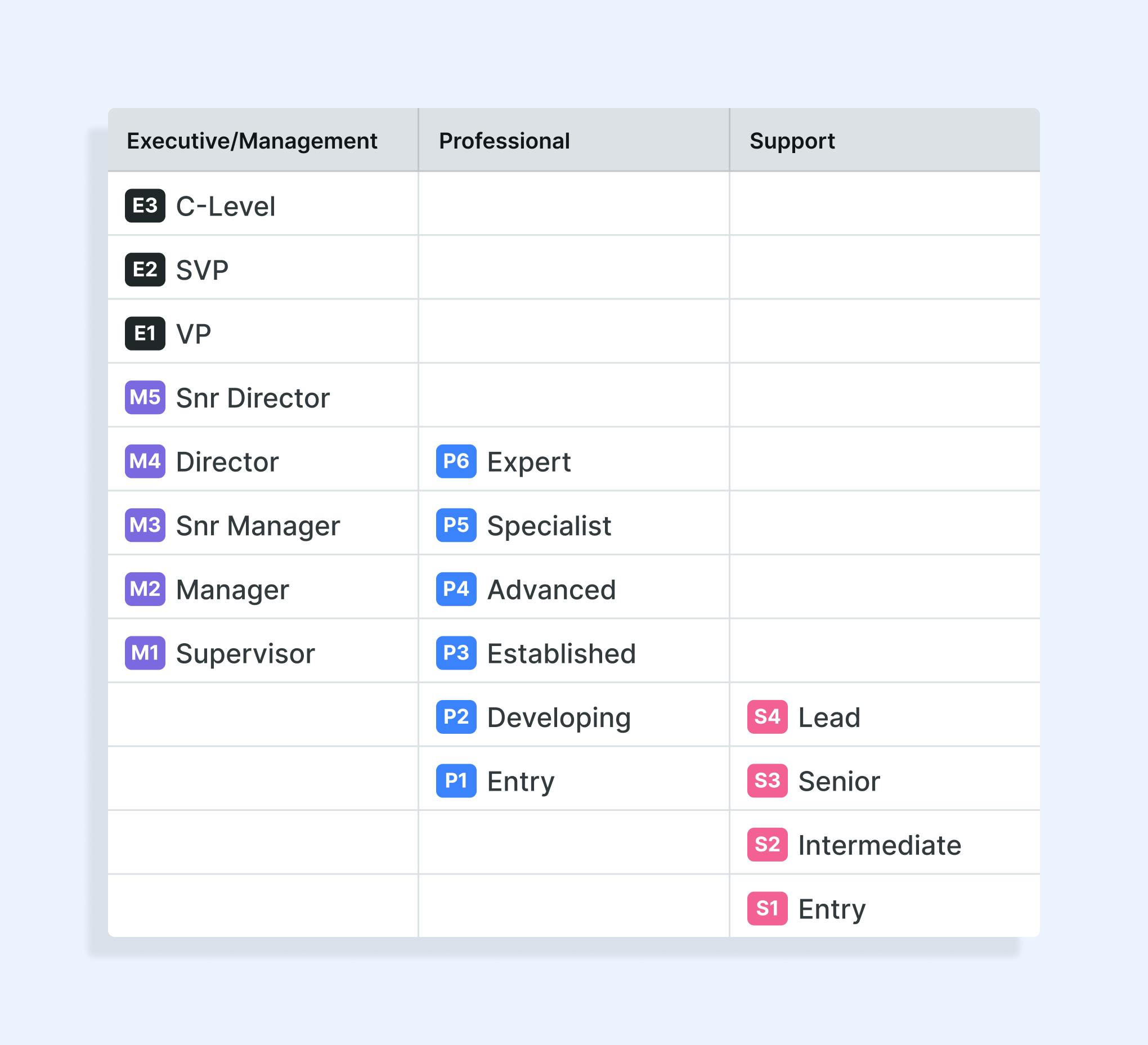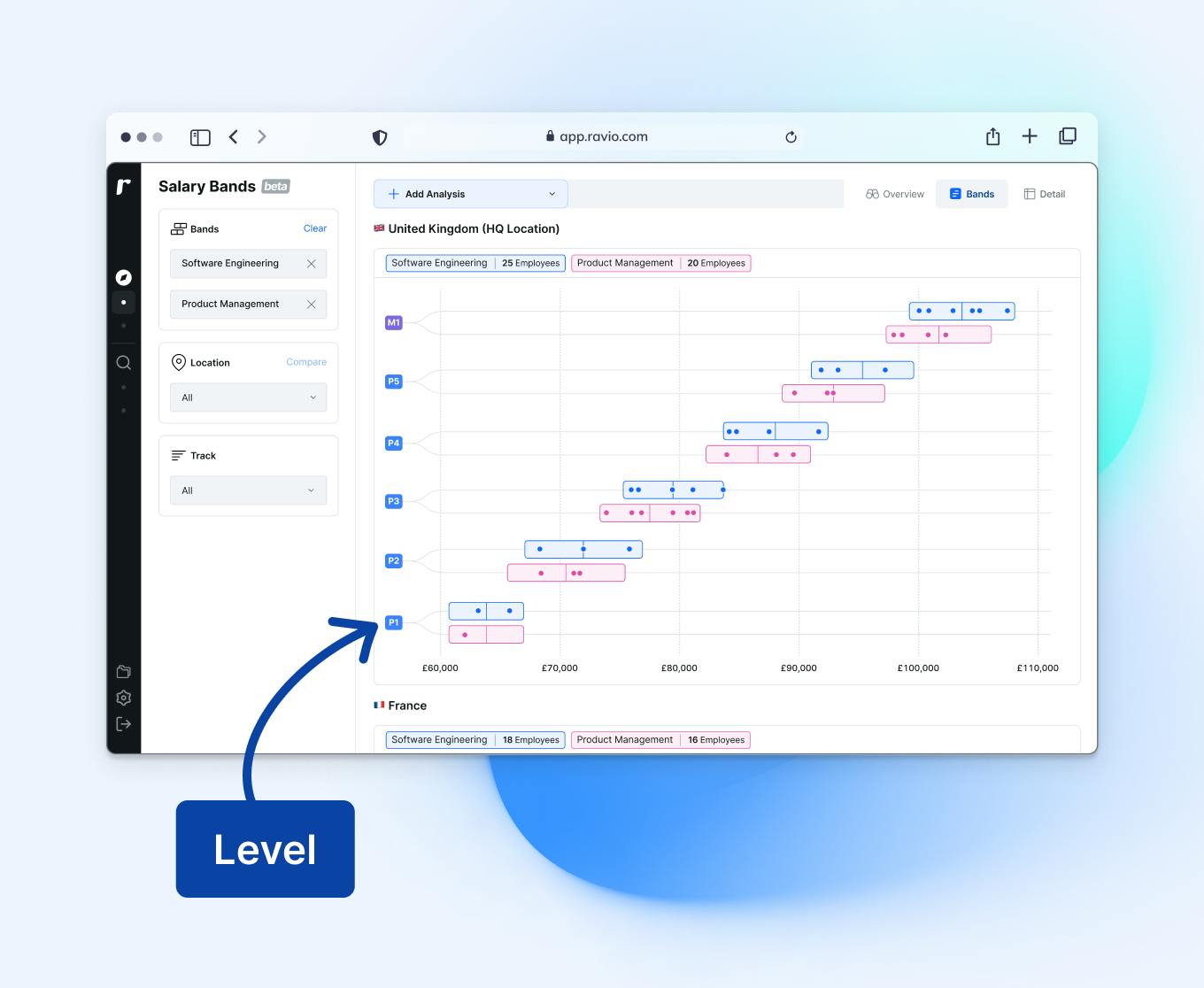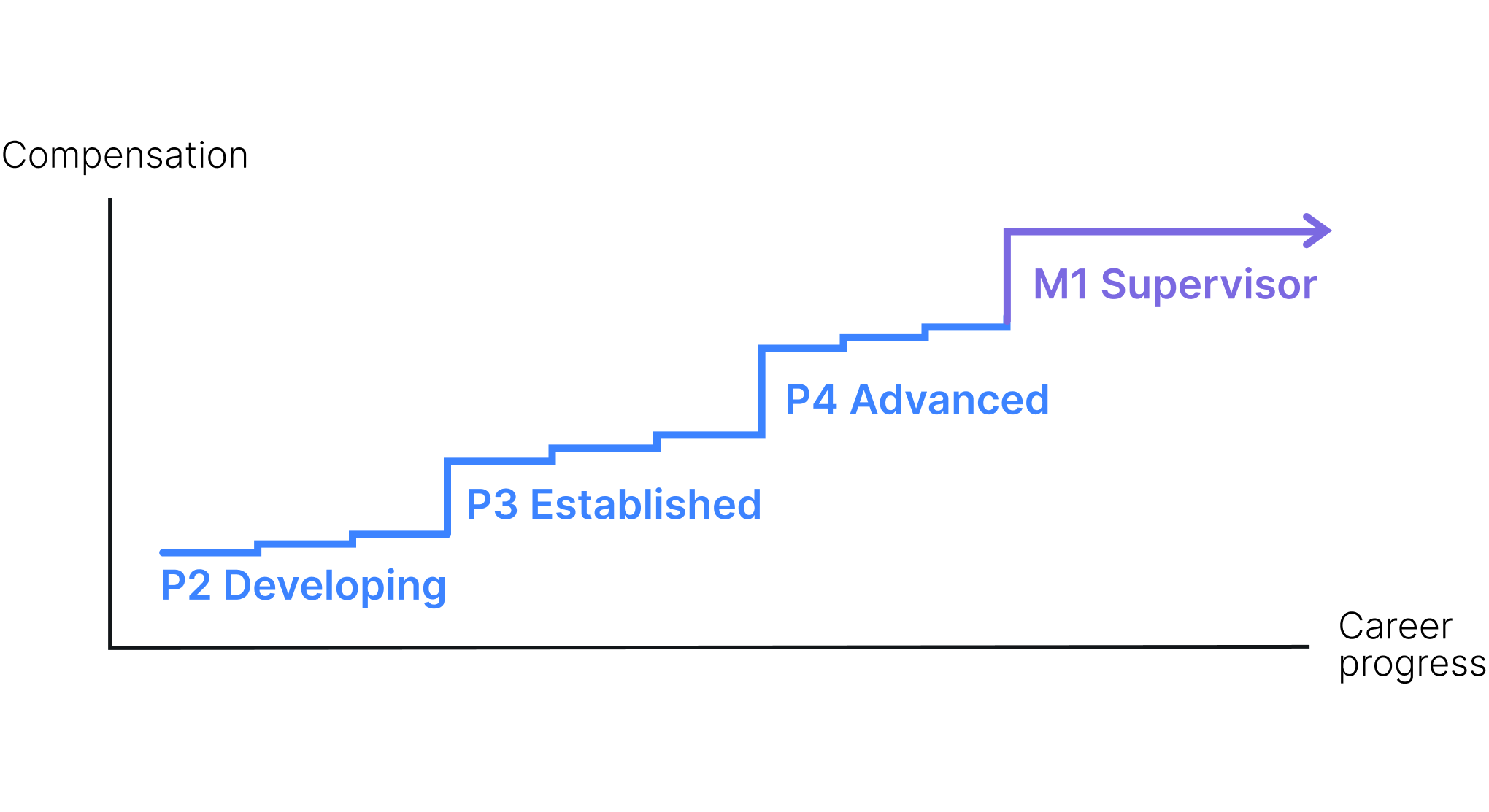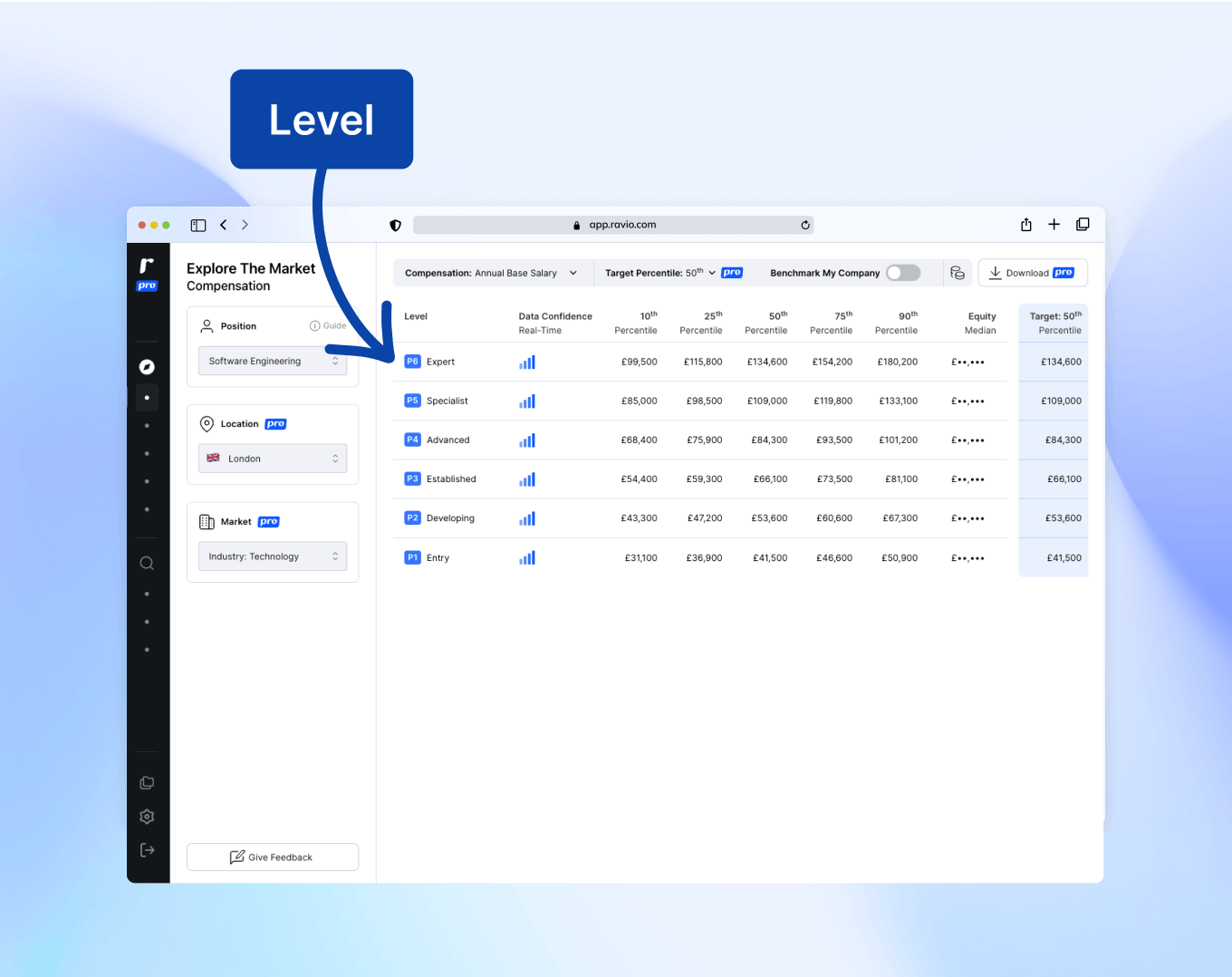A level framework is a vital piece in the people puzzle.
It enables clear expectations for both company and employee on roles and responsibilities, pay, and progression pathways.
But how do you create a best practice level framework?
Subscribe to our newsletter for monthly insights from Ravio's compensation dataset and network of Rewards experts, to help you navigate a career in compensation 📩
What is a level framework?
A level framework is the hierarchy of job positions within an organisation – part of the overarching job architecture.
Different companies create their level framework in different ways, but a typical structure includes three career tracks:
- Executive: leadership roles which oversee core functions
- Manager: oversees a team, with success measured based on the team’s output and impact on the business
- Professional / Individual contributor: success is measured based on individual output and impact on the business
Some companies also include a fourth career track – generally for large companies with a higher number of employees:
- Support: offer support to professional or manager roles, or complete manual and task-driven work.
Each of these career tracks contains a hierarchy of levels.
The levels are defined by expectations such as the level of responsibility, business impact, autonomy, skills and competencies needed, and so on – which may vary across different job families.
For instance, this is an overview of the career tracks and levels within Ravio’s own level framework:

A snapshot of Ravio's level framework
The level structure is fundamental to career progression – outlining the responsibilities, experience, impact etc that an employee needs to demonstrate to progress to the next level in their career track – and so goes hand-in-hand with a company’s progression framework.
And, of course, as employees move up the levels, their salary should also increase commensurately – so, the level framework is a key component in building best practice salary bands, with salary bands created for each level in the level framework to give a clearly defined structure for pay progression, alongside career progression.

This image shows Ravio's salary bands tool
Stay up-to-date with the latest compensation trends and insights with our monthly newsletter 💌
Why is a levelling framework important?
Having a well-structured framework of the job levels in a company means:
- Role expectations and career progression pathways are clearly defined
- A clear understanding of what competitive compensation looks like
- It’s easy to keep track of internal pay equity and avoid any issues.
Role expectations and career progression pathways are clearly defined
A hierarchy of job levels that is clear and includes the detail of the responsibilities, expectations, and capabilities at each level creates shared understanding and a common language for compensation and career progression within a company.
For the people team, it becomes easy to ensure fair and consistent compensation decisions are always made, because everyone is working from the same structure.
And for employees the increased visibility and understanding of the rationale behind compensation and career progression decisions improves perceived fairness and engagement.

A clear understanding of what competitive compensation looks like
Once you have a robust level framework it’s easy to map your internal job levels to market compensation benchmarking data like Ravio’s across those different levels.
This means you can ensure your compensation is always competitive, whilst also being cost effective.

This image shows Ravio's salary benchmarking tool
It’s easy to keep track of internal pay equity and avoid any issues
A core principle of internal pay equity is that employees who do similar work at a similar level should be paid similarly e.g. all senior software engineers should receive similar pay.
But, it’s common that they aren’t – for reasons such as:
- Salary compression – a lack of pay progression for employees who have been in the company for a long time)
- Biases around hiring salaries or salary increases e.g. a gender pay gap wherein women are offered lower salaries and/or promoted less than men doing equivalent work
- Lack of consistency on hiring salaries or salary increases across different departments or offices.
Having a well-defined level framework means these are much less likely to occur in the first place, because there’s clear, shared understanding of levels and progression – and, once the level framework is combined with salary bands, it’s also easy to spot any inconsistencies and discrepancies and address them.

This image shows Ravio's salary bands tool
How many levels should your level framework have?
The main decision when determining the right level framework for your company is how many levels you want to differentiate between.
A basic structure with less levels (2-3 per track) means a less complex structure to manage.

But, it also means less nuance and detail goes into the structure, which can lead to issues over time:
- If you hire new job positions which don’t fit within that basic structure you’ll need to re-level your framework to make it work – which can happen several times if you’re a growing company e.g. as you add new levels of management. And if you don’t adjust the framework, you end up with…
- Lots of job positions are grouped together in one level, which doesn’t reflect the variance in responsibility and salary across those positions and means you’re much more likely to be under- and/or overpaying some employees.
- There’s less of a pathway for career progression and promotion.
- Inconsistencies are introduced e.g. a separate structure is created for executives or founders, or one function decides that they need more levels than exists so creates their own department level framework – which puts the consistency and fairness of overall compensation decisions at risk because there is no single structure by which all employees can be compared.
Because of this, it’s common for startups to start out with a more basic level framework, and then upgrade to a more advanced framework as the need for more granularity arises e.g. when preparing to hire/promote additional layers of management.
Our recommendation is that if you’re able to adopt a more advanced level framework with more levels early on you should, to avoid any of those issues – and that it should definitely be in place once you have 50+ employees.

Ravio's level framework
Best practice tips for creating your level framework
Alongside the number of levels, other decisions to make when building a level framework are:
- How many tracks should we have?
- What is the ideal management structure for our organisation to be effective? Should we have a separate progression pathway for individual contributors and managers?
- How do we treat support roles e.g. office manager, personal assistant? In the Ravio level framework we created a separate support track, because the progression typically looks very different from other roles
- How do we level our CEO compared to other c-levels?
- How will employees advance through the levels – what should ideal internal career progression look like?
We can’t make those decisions for you (we wish we could!), but we can share some best practice advice which will help to guide you along the way:
1. One level framework for the entire organisation. Avoid having multiple frameworks e.g. across different departments – the level framework should create consistency across all employees.
2. Create the level framework for the company’s future org chart. It’s common for companies to create a level framework based on the levels that currently exist amongst their employees, but that leads to issues later down the line when you want to hire someone new and their level doesn’t exist – including future roles keeps the level framework sustainable as the company grows.
3. Be clear and detailed about the scope of each level. The level framework should include the responsibilities, competencies, level of business impact expected, level of autonomy for each level, and it’s better to be more detailed than less here – this is crucial for levelling new job positions and employees and for deciding on progression and promotion.
💡 To give an example of this, in the professional track (P1 to P6) of the Ravio level framework each level is differentiated based on autonomy, impact, and expertise.
Let’s compare a P2 description to a P3 description, for instance:
P2 developing:
- Expertise: Has working knowledge and experience in own discipline
- Autonomy: Receives moderate guidance and direction
- Impact: Low to moderate impact on success of own function/discipline
P3 established:
- Autonomy: works independently with minimal guidance
- Impact: medium impact on success of own function/discipline
- Expertise: has in-depth knowledge of own discipline, acts as a resource for colleagues with less experience – may represent the level at which career stabilises for many years (or until retirement).
4. Connect the dots between your level and career progression frameworks. So that you know, for instance, that an employee typically spends 2-3 years at each level – with a top-performing employee spending only 1-2 years or a lower performer 3-4 years.
5. Get stakeholder alignment – particularly from from finance and leadership. The level framework is core to your people and compensation function, so it’s important that relevant stakeholders are bought into the structure. Typically the most key stakeholders for the level framework are and c-suite leaders (or founders in a founder-led business) who often have differing views on how levels should work, so it’s important that they get aligned behind the structure, and the finance team who hold the keys to the budget for compensation.
6. Stress test your level framework with an employee focus group. Once you have stakeholder alignment, it’s also a good idea to test the framework with a group of employees and see their reactions – after all, your employees are your stakeholders too when it comes to levels and progression! This one is a top tip from Ravio’s own Chief People Officer, Vaso Parisinou:
“Top tip: after you’ve got alignment from the relevant stakeholders, you may want to stress-test your level framework with an employee focus group. I’m always stunned by the impactful and nuanced observations they provide!”

Chief People Officer at Ravio
💡 Ravio can level your company for you, in a matter of days
We know that even with a structured approach like we’ve outlined in this article, it takes a huge amount of time to create a robust level framework, get that stakeholder alignment, and level all employees – it’s a painful process.
When you register with Ravio, we automatically level your employees against our best practice level framework to ensure you have access to the most accurate salary benchmarking information – and we do this in a maximum of 5 days. We’ve designed our level framework to:
- Be universal: we haven’t reinvented the wheel, we just synthesised the most typical approaches into an effective structure
- Have nuance and detail, but still be easy to understand and as objective as possible
- Work for small and large companies alike, with enough levels to grow with your company.
Many companies even then choose to adopt our level framework for their own internal use, to make things even easier.
Want us to level your company for you? Get started here – and our team will be in touch to talk you through the process and answer any questions you may have.



